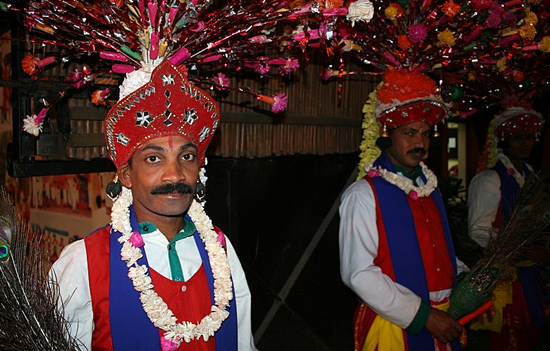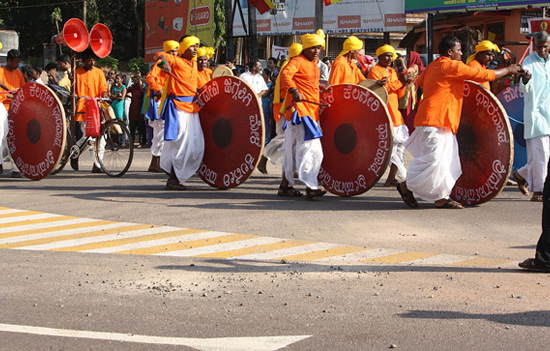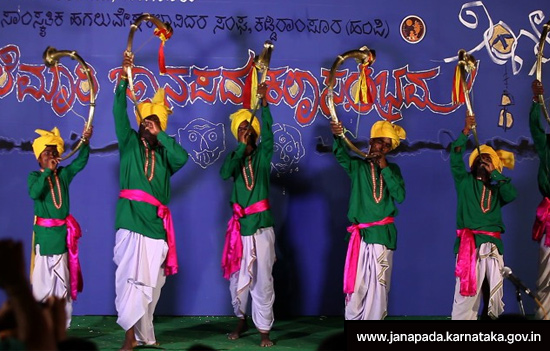- Know about how the folk festivals of Suggi Kunita, Jaggalige
Mela, Kombu-Kahale are celebrated in Karnataka and their respect for flora and
fauna.
In our country, our vibrant society and culture boast different dance forms. Bharatanatyam, Kuchipudi, Kathakali and Mohiniattam of South India, Odissi of Odisha, Rasleela of Manipur, Sattariya of Assam, Kathak, etc. are some dance forms that proudly reflect regional cultures. Many acclaimed artists have promoted the classical dances— Rukminidevi and Dr. Padma Subramanyam of Bharatanatyam; Birju Maharaj, Gopi Krishna, Manjari Chaturvedi of Kathak; Kalamandalam Krishnan Nair of Kathakali. There is also a Bharatanatyam format called Mysore Baani patronised by the rulers of the then princely state of Mysore and practised by Padma Bhushan awardee Dr. K. Venkatalakshamma.
This
article was first published in the Bhavan Journal.
Apart from these traditional dance
forms, we have janapada dances that enrich our culture. Janapada dances of
Karnataka demonstrate how the people praise the gods and enjoy life through
dance. Dollu Kunita, Kamsale, Yakshagana, Somana Kunita, Suggi Kunita, Karadi
Kunita, Lavani, Krishna Parijaata of North Karnataka, Huttari Dance and Bolak
Ath of the Coorg region, Bhootaradhane of South Canara region are in existence
even today. Formerly, these janapada dances were performed at night till dawn
as the farmers used to be busy with their farming all through the day and this
would refresh them after their hard work. Some of the Janapada dances are
Pattada Kunita, Suggi Kunita, Poorvantika, Jaggalige, Nagari Kunita, Jade
Kolata and many more.
Suggi Kunita

The festival of Suggi revolves around
performing puja to the new crop during the harvest season. It is celebrated by
offering puja to the grama devatas of
the particular region.
There is a mythological story behind
Suggi Kunita. Once in Kailasa, Gange and Gowri wanted their children to learn
an art form. The children rejected many as they were practised by ordinary
people. However, they were interested to learn Suggi Kunita. When they
presented the same in front of Lord Shiva, he was not satisfied and cursed
them. The ornamental sticks held by the children fell down, one of which was
picked by a boy of Halakki tribe.
Now, the dancers
observe certain conditions such as renouncing non-vegetarian food during this
period and preserving the greenery of the surroundings. This tradition
is still in vogue says the present day artistes.
Performance of Suggi Mela
The village head worships all the dance
equipment like the different drums, bugles and trumpets, the ornamental sticks,
etc. He distributes auspicious black rice among the performers who knot them to
their waists. Later, they reach main arena called Karikana which is about 3 m high. All the instruments are hung on a
pillar installed there. This is called Suragi
Kambha.
This act is performed in the beginning
of harvest season which goes on for about two weeks. During this period, the
performers strictly avoid non-vegetarian food.
The dresses used by these artistes are colourful with headgear made of multicoloured papers which are artistically ornamented. They wear brightly coloured sarees coming down to the ankles and bright yellow kurtas. Along with these artistes, there are also men wearing masks—such as a bear, Hanuman, policeman and thief—and also of various saints from the Puranas.
The artistes dance to the tune of the
janapada songs holding long decorated sticks. It is a rhythmic and visual
spectacle.
Jaggalige Mela

Jaggalige is a flat, circular percussion
instrument, the size of a large wooden cartwheel. This is a special instrument
particular to the North Kanara region. The recent interest in the Mela and the
instrument is due to sustained research by a group of enthusiasts in Hampi
Kannada University.
Jaggalige also means a large drum
(Ranahalage). This name is suited to this instrument because of its size, opine
researchers. It has a diameter of about four to five feet. The wheel is aptly
fitted with tanned buffalo leather and its face is etched with colourful
sketches. Because of its size this cannot be played like other percussion
instruments. While rolling it in one hand, the artistes beat the drum with a
stick with the other hand. This is complemented by nearly 20 artistes joining
in with other instruments. Every artist is colourfully attired in traditional
rustic dhoti, a waist band and upper garment.
It is understood that this form of art is restricted to Dharwar district of Karnataka. Because of the size of the instrument, the artistes cannot execute any dance steps. According to researchers, this is similar to ‘Alavi’ and ‘Hejje Kunita’ of that region.
In Karnataka, there are many types of
percussion folk instruments. There is a demand for Jaggalige, because of its
rarity.
Kombu-Kahale

This is a bugle which is common in many
parts of our country. Any village festival is heralded by the playing of the
bugle. In South Canara region, a sect called Nalike use this instrument during
Kambala, the buffalo race, a popular event in the region.
The instrument is very popular and has a mythical origin—from Sri Krishna’s conch Panchajanya in the Mahabharata. During wars, the King was accompanied on the battlefield with the playing of the bugle. This is repeated when he comes back victorious. A guard standing atop the fort sounds the bugle which alerts the royal army about invasions. Earlier during marriage or any other auspicious programmes, the sound of the bugle was compulsory. The practice is still continued in temples.
The artistes who play these instruments
during the show wear traditional Dhoti and shirt along with a coat and a
colourful turban. Most of them are farmers and participation in public events
is out of passion and as a hobby. To play these instruments, they need to be physically
and mentally strong. They have to play continuously for more than half an hour,
while controlling their breath and maintaining rhythm. Generally, the bugles
are made of brass and they are S-shaped. Two to three different sized bugles
are played alternately. The sound produced is slightly different but equally
melodious.
In this way, our janapada or folklore
has fostered many such arts. Nobody knows the origin of the same. It has come
down from generation to generation which can be seen even today. These
traditions are symbols of our rich rural culture and tell us how we should
respect our land, and its flora and fauna.
This article was first published in the Bhavan’s Journal, January 1, 2025 issue. This article is courtesy and copyright Bhavan’s Journal, Bharatiya Vidya Bhavan, Mumbai-400007. eSamskriti has obtained permission from Bhavan’s Journal to share. Do subscribe to the Bhavan’s Journal – it is very good.
To read all
articles on Indian Dance Forms
Also
read
1. Folk
dances of Northeast India
2. Folk
dances of North India
3. Folk
dances of South India
4. Adivasi
Dances
5. Folk
dance forms of Odisha